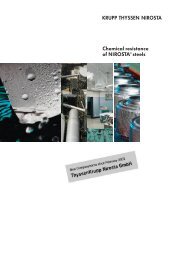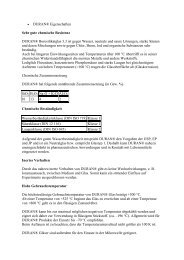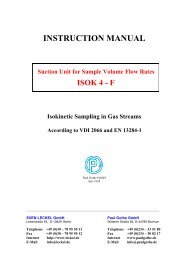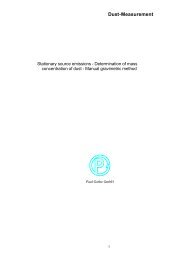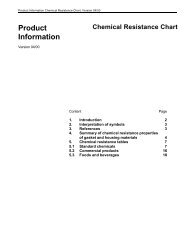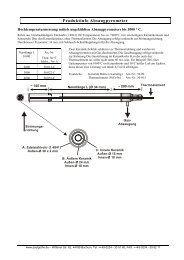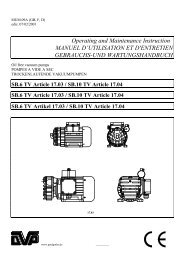Silica Gel - Paul Gothe GmbH
Silica Gel - Paul Gothe GmbH
Silica Gel - Paul Gothe GmbH
Create successful ePaper yourself
Turn your PDF publications into a flip-book with our unique Google optimized e-Paper software.
Material Specification<br />
SPEC-NO.: SIO – 06 February 2003<br />
Brand Name: SIOGEL ® , small porous, blue "Indicating Type"<br />
(<strong>Silica</strong> <strong>Gel</strong>)<br />
Rev.: 00<br />
Page 1 of 2<br />
Product Description: glassy, hard, irregular shaped granules with a very high purity of approx. 99<br />
% SiO2 (dry basis) and an internal surface area of approx.<br />
800 m 2 /g!<br />
Because of its very large surface area SIOGEL exhibits a high<br />
adsorption for water vapour.<br />
SIOGEL "Indicating Type" contains 0,3 - 0,4 % of Cobalt (as Co). The<br />
blue granules change colour to pink when saturated and exhausted. The<br />
change of colour is reversible. The material changes colour back to blue when<br />
being reactivated. SIOGEL, small porous, blue "Indicating Type" conforms to<br />
US MIL-D-3716 A, Type IV, Grade H<br />
BS 3523<br />
German TL 6850-0028<br />
Formula: SiO2 . n (H2O) - amorphous form of silica<br />
CAS-Nr.: 7631-86-9 (<strong>Silica</strong>)<br />
7646-79-9 (CoCl2)<br />
Physical Characteristics: Typical water vapour<br />
adsorption capacity<br />
Standard grain sizes: 1,0 - 3,15 mm<br />
at 20 % rel. humidity = approx. 10,0 %<br />
at 40 % rel. humidity = approx. 21,5 %<br />
at 80 % rel. humidity = approx. 31,0 %<br />
loss on ignition (950 °C) max. 7,0 % (on<br />
dry basis)<br />
Bulk density 650 - 750 g/l
MATERIALSPEZIFICATION<br />
SPEC-NO.: SIO - 06 February 2003<br />
Rev.: 00<br />
Page 2 of 2<br />
Applications: SIOGEL "Indicating Type" is a desiccant intended for the removal of moisture from air,<br />
other gases, and liquids by static and dynamic means.<br />
The material is impregnated with an indicator (Cobalt) and should be used<br />
whenever a visual indication of the degree of saturation of the desiccant is<br />
required.<br />
The temperature at reactivation should not exceed 110 °C<br />
Handling: SIOGEL must always be kept in airtight containers to avoid preadsorption with water<br />
vapour. Face masks should be used at continual exposure to extensive<br />
dusting.<br />
Note:<br />
Any details of application possibilities do not free the purchaser from the obligation of performing his own tests<br />
on the material supplied by the seller in order to determine their suitability for the intended processes and<br />
purposes. Application, use and processing of the material cannot be controlled by the seller and are thus the sole<br />
responsibility of the purchaser.
Safety Data Sheet<br />
*1. Identification of the substance/preparation and the company<br />
SILICA GEL BLUE<br />
Application:<br />
Drying agent<br />
<strong>Paul</strong> <strong>Gothe</strong> GMBH<br />
Wittener Straße 82, 44789 Bochum<br />
www.paulgothe.de<br />
*2. Composition/information on ingredients<br />
preparation containing<br />
silicid acid, amorphous<br />
weight % > 99<br />
CAS No.: 7631-86-9 Index No.: -<br />
hazard symbol: -- EINECS No.: 231-545-4<br />
R-phrases: -<br />
cobalt dichloride<br />
weight %: 0,2-0,9<br />
CAS No.: 7646-79-9 Index No.: 027-004-00-5<br />
hazard symbols: T, N EINECS No.: 231-589-4<br />
R-phrases: 49(Carc. Cat. 2)-22-42/43-50/53<br />
*3. Hazards identification<br />
Hazard description:<br />
May cause cancer by inhalation.<br />
Harmful to aquatic organisms, may cause long-term adverse effects in the<br />
aquatic environment.<br />
*4. First-aid measures<br />
After inhalation take the patient into the fresh air. Call a doctor if<br />
necessary.<br />
In the event of contact with the skin, rinse off with water and soap.<br />
Contamination of the eyes must be treated by thorough irrigation with<br />
water, with the eyelids held open.<br />
In case of persistent irritation of the skin and/or eyes seek medical<br />
advice.<br />
If product is swallowed consult a doctor.<br />
5. Fire-fighting measures<br />
Suitable extinguishing media:<br />
No restriction in fire situations.<br />
Product is not combustible.<br />
For reasons of security unsuitable extinguishing media:<br />
none<br />
(to be continued)<br />
in accordance with the EU Directives (gb)
Date of issue: February 7, 2005<br />
Revised: February 7, 2005<br />
SILICA GEL BLUE<br />
5. Fire-fighting measures (Continuation)<br />
Special risk due to the substance or the preparation itself, its combustion<br />
products or the gas being produced:<br />
In case of fire, cobalt oxide and hydrogen chloride is formed.<br />
Special protective equipment when fighting fires: Firemen<br />
have to wear self-contained breathing apparatus.<br />
further information:<br />
none<br />
*6. Accidental release measures<br />
Precautionary measures regarding persons:<br />
Avoid formation and deposition of dust.<br />
Ensure effective ventilation.<br />
Avoid contact with skin and eyes and the inhalation of dust. Use the<br />
personal protective equipment listed in Chapter 8.<br />
Environmental protection measures: Do<br />
not empty into drains or waters.<br />
Methods for cleaning up/taking up:<br />
Take up mechanically; avoid dust formation. Fill into labelled, sealable containers.<br />
Note German Technical Regulation on Dangerous Substances No 200/201.<br />
further information:<br />
none<br />
*7. Handling and storage<br />
Handling<br />
Information on safe handling:<br />
Avoid formation and deposition of dust. During processing, ensure efficient exhaust<br />
ventilation in the working area.<br />
Information on fire and explosion prevention:<br />
none<br />
(to be continued)<br />
in accordance with the EU Directives (gb)
Date of issue: February 7, 2005 Revised:<br />
February 7, 2005 SILICA GEL BLUE<br />
*7. Handling and storage (Continuation)<br />
Storage<br />
Requirements on storerooms and containers:<br />
The Wasserhaushaltsgesetz (Water Resources Management Act) and the relevant<br />
Landeswassergesetz (local waste water legislation) and the Regulations on<br />
Plants for Storing, Filling and Transportation of Substances which are<br />
Hazardous to Water must be observed.<br />
Information on common storage:<br />
Observe the rules contained in the VCI concept for separate/common storage.<br />
Observe official regulations.<br />
Further information on storage conditions:<br />
Keep in sealed containers in a dry place. Note German Technical Regulation on<br />
Dangerous Substances No 514.<br />
storage class according to VCI (Association of the German Chemical Industry):<br />
6.1BS<br />
*8. Exposure controls/Personal protection<br />
For exposure controls see Chapter 15.<br />
Respiratory protection: Respiratory equipment with filter type P according to DIN EN<br />
143<br />
Hand protection:<br />
Suitable materials for safety gloves:<br />
Natural rubber, nitrile rubber, butyl rubber<br />
Details of material thickness and breakthrough time: Not<br />
applicable for non-dissolved solids / dusts.<br />
Eye protection: goggle.<br />
Physical and chemical properties<br />
*9.<br />
(to be continued)<br />
in accordance with the EU Directives (gb)
Date of issue: February 7, 2005 Revised: February 7, 2005 SILICA GEL BLUE<br />
*9. Physical and chemical properties (Continuation) tested in accordance with<br />
Partition coeffizient<br />
n-octanol/water not determined<br />
*10. Stability and reactivity<br />
Conditions to avoid:<br />
none<br />
Substances to avoid:<br />
none known<br />
Hazardous decomposition products:<br />
Formation of cobalt oxide and hydrogen chloride possible during thermal<br />
decomposition.<br />
further information:<br />
none<br />
*11. Toxicological information<br />
Toxicological tests<br />
Acute toxicity:<br />
LD50 oral, rat: 3160 mg/kg<br />
(applies to silicid acid, amorphous)<br />
LD50 oral, rat: 80 mg/kg<br />
(applies to cobalt dichloride)<br />
The following results refer to cobalt dichloride.<br />
sensitization:<br />
cobalt dichloride can sensitize the skin and respiratory passages and cause<br />
allergic reactions.<br />
Effects after repeated or prolonged exposure:<br />
Repeated intake of cobalt dichloride may cause myocardial damage.<br />
Carcinogenic effects:<br />
In animal tests the product gives an indication for a carcinogenic effect.<br />
12. Ecological information<br />
The results refer to cobalt dichloride.<br />
Aquatic toxicity:<br />
Acute fish toxicity:<br />
LC50: (Oncorhynchus mykiss): > 35,0 mg/l<br />
Acute toxicity for daphnia:<br />
EC50 (Daphnia magna): 11,8 mg/l<br />
(to be continued)<br />
in accordance with the EU Directives (gb)
Date of issue: February 7, 2005 Revised: February 7, 2005 SILICA GEL BLUE<br />
12. Ecological information (Continuation)<br />
Toxicity to bacteria:<br />
120 h EC50 (activated sludge): 64,0 mg/l<br />
13. Disposal considerations<br />
Unused material: reuse if possible. Address manufacturer.<br />
Or:<br />
May be disposed of in approved landfills provided local regulations are<br />
observed.<br />
*14. Transport information<br />
GGVSE: -- UN: -- PG: -<br />
RID/ADR: -- UN: -- PG: -<br />
Warning sign: Hazard no. - --- UN No.: ---<br />
ADNR: -- UN: -- PG: -<br />
GGVSee/IMDG Code: -- UN: -- PG: -- MPO: -<br />
ICAO-TI/IATA-DGR: -- UN: -- PG: -<br />
Declaration for land shipment: -<br />
Declaration for sea shipment: -<br />
Declaration for shipment by air: -<br />
Other information:<br />
Not dangerous cargo. Keep separated from foodstuffs.<br />
*15. Regulatory information<br />
Labelling in accordance with the EEC directives:<br />
Symbol: T, hazard description: toxic<br />
Contains: cobalt dichloride<br />
R 49: May cause cancer by inhalation.<br />
R 52/53: Harmful to aquatic organisms, may cause long-term adverse effects<br />
in the aquatic environment.<br />
S 53: Avoid exposure - obtain special instructions before use.<br />
S 45: In case of accident or if you feel unwell, seek medical advice<br />
immediately (show the label where possible).<br />
S 61: Avoid release to the environment. Refer to special<br />
instructions/Safety data sheets.<br />
German regulations<br />
"Only for professional use"<br />
TRGS 900 "Atmospheric Threshold Value":<br />
7631-86-9 silicid acid, amorphous threshold: 4 mg/m³ E<br />
Note remarks<br />
Handling restrictions:<br />
Jugendarbeitsschutzgesetz (JArbSchG) § 22<br />
Mutterschutzrichtlinienverordnung (MuSchRiV)§ 5<br />
Major accidents regulations: not listed in the appendices<br />
(to be continued)<br />
in accordance with the EU Directives (gb)
Date of issue: February 7, 2005<br />
Revised: February 7, 2005<br />
SILICA GEL BLUE<br />
*15. Regulatory information (Continuation) Technical<br />
Instruction on Air Pollution Control: Figure 5.2.2<br />
Class II<br />
cobalt and his compounds, stated as Co<br />
Water pollution class (WGK): 1 - slightly hazardous to water<br />
WGK = Classification in accordance with the German Water Resources Act<br />
Observe national regulations.<br />
Observe national regulations.<br />
*16. Other information<br />
Text of all R phrases referred to in sections 2 and 3: R 49: May<br />
cause cancer by inhalation. R 22: Harmful if swallowed. R<br />
42: May cause sensitization by inhalation.<br />
R 42/43: May cause sensitization by inhalation and skin contact.<br />
R 43: May cause sensitization by skin contact.<br />
R 50: Very toxic to aquatic organisms.<br />
R 50/53: Very toxic to aquatic organisms, may cause long-term adverse<br />
effects in the aquatic environment.<br />
R 52/53: Harmful to aquatic organisms, may cause long-term adverse effects<br />
in the aquatic environment.<br />
R 53: May cause long-term adverse effects in the aquatic environment.<br />
The presented Safety Data Sheet has been altered.<br />
The reason for the alteration is as follows: revised text (see chapter 1, 2, 3, 4, 6,<br />
7, 8, 9, 10, 14, 15 and 16)<br />
labelling (see chapter 15)<br />
The data given here is based on current knowledge and experience. The purpose<br />
of this Safety Data Sheet is to describe the products in terms of their safety requirements. The<br />
above details do not imply any guarantee concerning composition, properties or performance.



